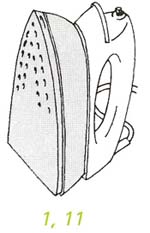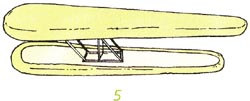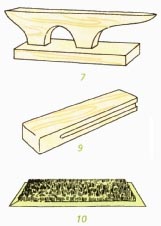 
The real secret of success in sewing is to press as you sew. Careful, thorough treatment during each stage of construction will result in a good-looking garment that requires only a light touch-up when completed. You will find that it is quicker and easier to press in units as you sew. For example, stitch and press all darts and pocket flaps, and so on. The iron should combine the characteristics of both a steam iron and a dry iron. The steam vents should be located at the end of the soleplate to provide concentrated steam when it is needed. Be sure the iron has a wide temperature range for the best care of all you fashion fabrics. A controlled spray and surge of steam mechanism can also be helpful. (1) The ironing board should be sturdy, level and adjustable to different heights. Pad the board with cotton batting or purchased padding already cut to fit. Place a silicone-treated cover over the surface to prevent scorching or sticking. Keep the cover smooth and clean. Press cloths should be selected in relation to the weight of your fabric. They should be similar in weight for best results. Have at least three on hand: a transparent variety for seeing details, a two-part wool and cotton type for most general pressing needs, and a non-stick or Teflon type for fusibles. For pressing on the right side, use a scrap of the garment fabric as a press cloth. Keep cheesecloth available for ready use as a press cloth (2). |
 A tailor’s ham is an oblong, firmly stuffed cushion with subtly rounded curves, It is designed for pressing the curved areas of your garment such as darts, sleeve caps, princess seams, or any place that requires a rounded, curved shape pressed in. There are no substitutes for this item as it simulates actual body curves. Hams come in different sizes and should be covered in half cotton and half wool. One version has a concave as well as a convex section (3). A press mitt is similar to a tailor’s ham, but small enough to fit over your hand. It has pockets on either side to protect your hand. The mitt is good for small hard-to-reach areas or it may be slipped over the end of a sleeve board for sleeve caps. It also may be covered on one side with wool and on the other with cotton (4). A sleeve board is actually two small ironing boards attached one on top of the other. They are designed for pressing small or slim areas, such as sleeves or necklines that do not fit over your regular board. It should have a silicone cover and padding (5). A seam roll is a long, firmly stuffed, tubular cushion that is rounded at each end. It is used to press small, curved areas and long seams in hard-to-reach areas such as sleeves. Because the roll is rounded, you press only the seam and not the surrounding fabric. This prevents ridges from forming on the right side. Again, one side should be covered with wool and the other side with cotton. To make a seam roll, cover a tightly rolled magazine with scraps of fabric (6). 
|
Are you looking for sewing or crafts-related items such as sewing machines, sergers, yarn, and knitting supplies? Try our online catalog pages here.
Or see what products on our site the popular search engines have chosen to list...
- Google listing of all "Sewing" items on our site
- Yahoo! listing
of all "Sewing" items on our site
- Alta Vista listing of all "Sewing" items on our site
Recommended Reading
Recommended Products
5 Drawer Foldaway Desk: Perfect for your sewing machine or serger! Constructed from durable melamine laminated particle board the Mobile Desks will offer a life time of reliable service.
If you need specific sewing supplies, browse through the products on pages like these:
- Brands of Overlock Serger Sewing Machines: Brother Serger and Coverstitch Machines and related items
- Singer Needles for Home Sewing Machines
- Industrial Sewing Machine Accessories

A point presser or pressing board is made of wood and provides many differently shaped surfaces for pressing points, curves, and straight edges. The different sizes of curves and narrow straight edges allow you to press seams flat and open without wrinkling the surrounding area. The board can be used as it is for firm fabrics and sharp edges, or covered with a contoured pad for softer edges (7).
A pressing pad is three or four thicknesses of soft fabric stitched together to make a padded surface for pressing monograms, buttonholes, sequined fabric, and other raised surfaces. Place the raised surface face down on the pad and press on the wrong side. The pad prevents puckers and flattening of the decoration. A heavy Turkish towel may be substituted. (8)
A pounding block or clapper is a block of wood used with steam to flatten seam edges. It was originally designed to be used on hard-finished woolens and linens, but it may be used to form soft rolled hems. It is a must for tailoring. First make as much steam as possible with a steam iron and a damp press cloth. Remove the iron and cloth and pound firmly, regulating your pressure and slapping motions to suit the desired edge. (9)
A needle board is a bed of needles mounted on a flat surface that is placed between your fabric and the ironing board to prevent flattening pile fabrics. When the fabric is placed face down on the board, the pile falls in between the needles. It is essential for pressing velvet and other high-piled fabrics and very useful when pressing easily marred woolens. Also available with a stiff, high-pile fabric surface instead of needles. (10)
An iron cover is placed over the soleplate of your iron and is used instead of a press cloth to prevent shine and scorching. One type is made of pre-formed heat-resistant fabric stretched over a metal frame and attaches to the iron with a spring; another is made of wool or canvas and has a drawstring for adjustment. (11)
Brown paper is essential. Strips should be placed under the folds of darts or the edges of pleats, etc., to avoid unsightly ridges from appearing on the right side.
